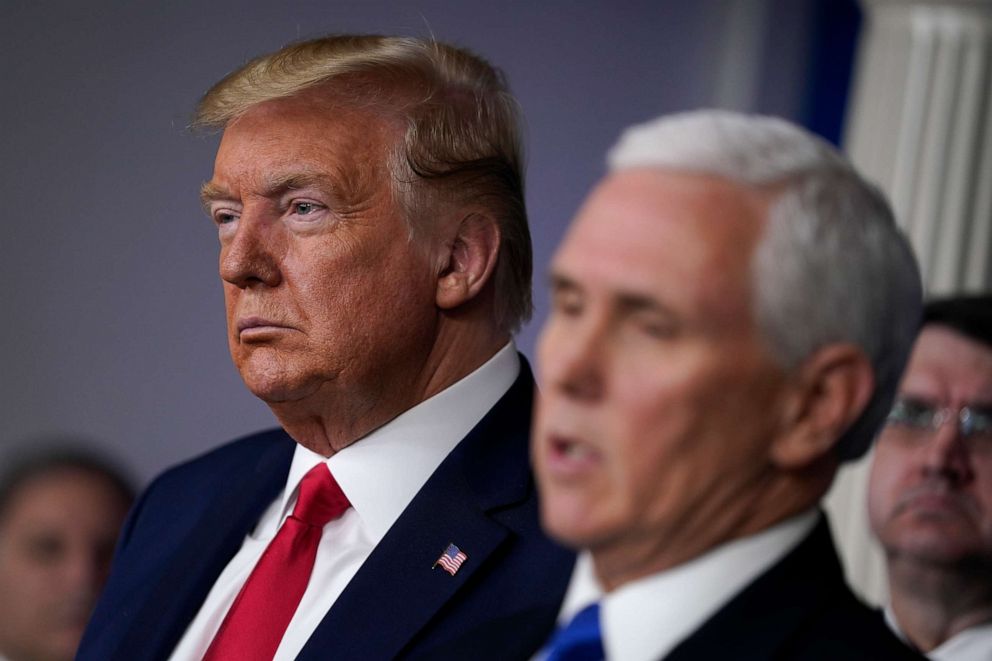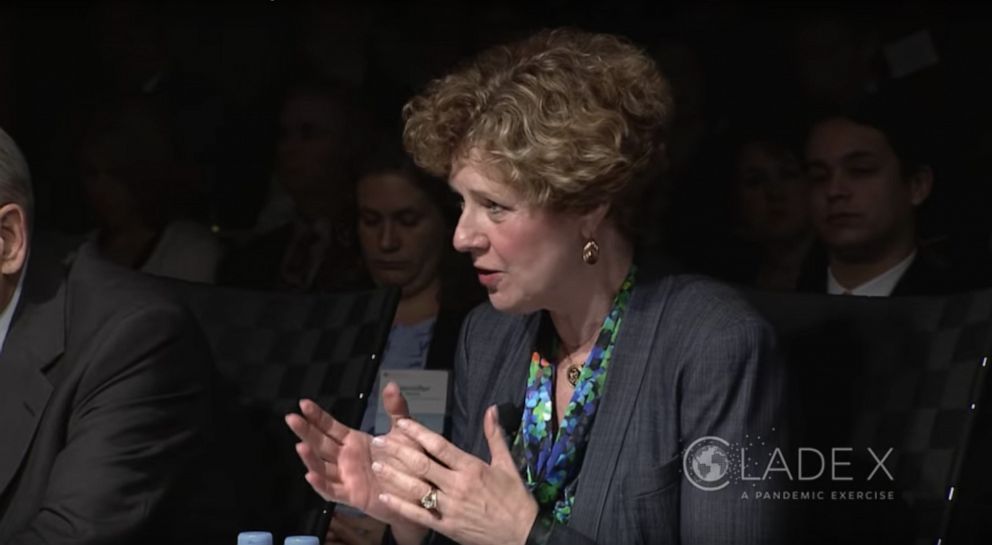Online videos 'predicted' details of deadly outbreak, but Trump called coronavirus 'unforeseen problem'
YouTube videos captured a 2018 simulation and "eerie" similarities to today.
Two years ago, during a simulated meeting of the nation’s top officials, a former senator acting as the U.S. defense secretary offered a chilling assessment of a "new" deadly disease spreading across America: “We’re going to have a lot of casualties in this war against this epidemic.”
One of the simulation's organizers, acting as a National Security Council official, warned that if a vaccine – which takes more than a year to develop – isn’t deployed “soon,” the U.S. death toll could be “catastrophic.”
Those in the room were then briefed on the latest situation on the ground: "Telework and social distancing measures are being encouraged by the CDC. Schools across the country are closed, and many public gatherings have been canceled.
“Public demand for surgical masks and respirators far exceeds the available supply. … Some states are now considering the feasibility of canceling in-person voting,” the room was told.
That scene could have been taken from the unfolding coronavirus crisis. But it was posted to YouTube in May 2018, when the Johns Hopkins Center for Health Security held a mock “executive committee” meeting to envision how the U.S. government could respond to a new infectious disease from overseas – a pretend pathogen dubbed “Clade X.”
Real-life experts, lawmakers and former officials took on the roles of high-level government decision makers, pulling from their own experience to navigate the dramatic scenarios that evolved before them.
The disease wasn't real, but the five-hour exercise exposed actual gaps in the government’s capabilities.
“We wanted to … propel people to want to make change,” Dr. Tom Inglesby, the center’s director, who played “national security adviser” in the exercise, told ABC News.
Inglesby and his team were "not as successful as we would have liked to have been” in propelling change, he said.

Now in the midst of the coronavirus crisis, “it is eerie” how “close in some ways” the May 2018 exercise “predicted” what would happen two years later, Rep. Susan Brooks, R-Ind., another participant in the exercise, told ABC News Wednesday.
Brooks, one of the leading Republicans in Congress on biodefense issues, said she left the “Clade X” exercise realizing, “This wasn’t going to be a matter of if we might have a pandemic one day, but when.”
Earlier this month, President Donald Trump described the latest pandemic as “an unforeseen problem.”
“Came out of nowhere,” he said on March 6, just before signing a bill to provide more than $8 billion in emergency funding to local, state and federal agencies.
‘Quite eye-opening’
Brooks defended Trump, saying she believes he was referring to the “particular” strand of coronavirus – COVID-19 – not the havoc it’s wreaking.
Nevertheless, public health and national security experts have been warning for years that the U.S. homeland wasn’t properly prepared to protect against a new infectious disease, and “Clade X” played a key part in some of those warnings.
Days after the exercise, the Washington Post declared in a headline: “This mock pandemic killed 150 million people. Next time it might not be a drill.”
A month later, during a House hearing, Rep. Greg Walden, R-Ore., described the simulation as “quite eye-opening,” especially the “failure to develop a vaccine within 20 months.”
“So, obviously, we’ve got to do more to be prepared for these types of outbreaks,” he declared.
Sitting in front of Walden ahead of their own testimony were three senior U.S. officials, including Dr. Anthony Fauci, the National Institutes of Allergy and Infectious Diseases director, who has become a trusted authority during the coronavirus crisis.
It's unclear if Trump or even his top aides were ever informed of the "Clade X" exercise. But several months later, in January 2019, U.S. intelligence agencies publicly issued a "worldwide threat assessment," which included a warning that outbreaks of infectious diseases “will be more frequent” and “could lead to massive rates of death and … severely affect the world economy.”
In a statement to ABC News, a White House spokesman said, "Any suggestion that President Trump did not take the threat of COVID-19 seriously or that the United States was not prepared for COVID-19 is false."

‘The biggest gap’
In 2018, the “Clade X” saga included some hypothetical scenarios that – even in the era of coronavirus – still seem far-fetched, including the president's hospitalization in critical condition and the conclusion that a terrorist group was behind it all.
But many of the developments, from “social distancing” and rising death tolls to travel bans and stock market crashes, now seem prescient.
At one point, participants in the exercise discussed how important it was to produce and distribute a diagnostic test that can confirm who's been infected with the disease.
“If we really have a diagnostic, that changes the whole situation,” former Food and Drug Administration Commissioner Margaret Hamburg, acting as the Health and Human Services secretary in the simulation, said at the time. “But I think we’re a little bit unsure about that.”
Facing the real-world challenge of coronavirus two years later, the U.S. government has been similarly scrambling to create and mass-produce an effective diagnostic test.
“That’s probably the biggest criticism and the biggest gap that we had,” according to Brooks, adding that even the senior U.S. officials who’ve briefed her on the coronavirus response “know that the testing issue was a significant concern.”
"It now is an issue just in maximum production, and how do we ramp it up and get it distributed throughout the country," Brooks said.

Last week, Trump said he takes no responsibility "at all" for the lag in testing.
"We were given a set of circumstances, and we were given rules, regulations, and specifications from a different time. It wasn’t meant for this kind of an event," he said. "What we’ve done is redesigned it very quickly ... and we’re now in very, very strong shape."
‘A radical shortening’
In November, a month before coronavirus first surfaced in China, Inglesby testified before a Senate Armed Services subcommittee, noting that the “Clade X” exercise also “shed light on how current timelines for [vaccine] production are too slow to be meaningful.”
On Tuesday, Trump announced that a “candidate” had begun a clinical trial for a coronavirus treatment, marking what he called “one of the fastest vaccine development launches in history.”
"That would have taken years to do not so long ago," Trump later said.
But it is still "going to be a long time before we have a coronavirus vaccine," Inglesby noted.
As it stands now, identifying potential vaccines, initially testing each of them, and then conducting clinical trials for promising leads takes at least a year, perhaps months more.
Inglesby said that “when we get through this crisis, we need a radical shortening of the timeline."
Two years before Fauci found himself in the middle of the coronavirus fight, he made a similar appeal to Congress.
In the June 2018 testimony a month after the "Clade X" exercise, Fauci said the timeline for new vaccines could be shortened to as little as "a couple" of months "if we put our mind and our resources to it."
But to shorten the timeline so much, he said, new technology would have to be developed “that’s applicable to any disease.”
“In other words, making a kind of vaccine that you can easily apply to whatever is the outbreak,” he explained two years ago.
That type of effort “is so, so difficult,” especially because it requires not only a big financial investment but also a greater government investment in building – and maintaining – partnerships with private companies, according to Anita Cicero, the Center for Health Security's deputy director.
An office inside the Department of Health and Human Services, the Biomedical Advanced Research and Development Authority (BARDA), specifically works with private industry to develop vaccines that the U.S. government could then purchase and stockpile.

Government agencies and private companies, however, have what Brooks described as a "complex relationship."
"It's a difficult enterprise for a private-sector company to produce vaccines if they aren't certain there's going to be a market for the government to buy them," she said. "These aren't things that ... your average medical provider tells people to go out and get."
At the same time, the federal government has "constrained resources," which means "attention just naturally goes to the fires burning at the moment," Cicero said.
Nevertheless, Brooks and Inglesby both said there has been at least some improvement in recent years, with Brooks citing significant increases of government spending at the National Institutes of Health, the Centers for Disease Control, and BARDA.
"But it's not enough," according to Inglesby.
“The challenge for us is that it’s never enough,” Brooks said. “And it will probably never be enough because there will always be emerging new diseases that we’ve never heard of.”
‘Stunning crisis’
For Inglesby, the bottom line is that recent presidential administrations – from both parties – needed to do more to fully prepare for a pandemic like coronavirus.
“I think there has been an instinct in the past for people to wonder if this kind of event would really happen in their term of office,” Inglesby said. “And there’s lots of things going on in the world [so] it’s difficult for pandemics to compete for attention with some of the other crises that are right in front of people.”
The SARS and H1N1 pandemics during the George W. Bush and Barack Obama eras were "warning shots" and "did for a time in each case ... generate some political commitment," Inglesby added. "But then with passage of time after these events, people [did] lose concern."
If coronavirus doesn’t change things, "nothing will,” Inglesby insisted. "This is a stunning crisis. ... We should never be in this position again.”
NIH did not respond to an email seeking comment for this article.
ABC News' Ben Gittleson contributed to this report.




